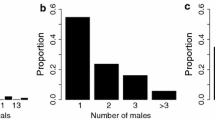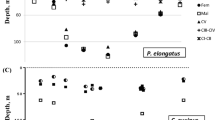Abstract
Dusky groupers (Epinephelus marginatus) are characterized by a complex sex allocation strategies and overexploitation of bigger individuals. We developed an individual based model to investigate the long-term effects of density dependence on grouper population dynamics and to analyze the variabilities of extinction probabilities as a result of interacting mortalities at different life stages. We conduct several simulations with different forms of sex allocation functions and different combinations of mortality rates. The model was parametrized using data on dusky grouper populations from the literature. The most important insights produced by this simulation study are that density dependence of sex allocation is an evolutionarily stable strategy, increases the population biomass, mitigates the effect of the removal of large male and indicates a need for protection of females and flexible stages.






Similar content being viewed by others
References
Andrade AB, Machado LF, Hostim-Silva M, Barreiros JP (2003) Reproductive biology of the dusky grouper Epinephelus Marginatus (LOWE, 1834). Braz Arch Biol Technol 46(3):373–381
Beverton RJH, Holt SJ (1959) A review of lifespans and mortality rates of fichs in nature and the relation to growth and other physiological characteristics. Lifesp Animals GEW 5:142–180
Bouain A, Siau Y (1983) Observations on the female reproductive cycle and fecundity of three species of groupers (Epinephelus) from the southeast Tunisian seashores. Marine Biol 73:211–220
Brusle J (1985) Expose synoptique des données biologiques sur les mérous Epinephelus aeneus (geoffroy Saint Hilaire, 1809) et Epinephelus guaza (Linnaeus, 1758) de l’ocean Atlantique et de la Méditerranée, Synopsis sur les Pêches, FAO
Buston P (2003) Social hierarchies: size and growth modification in clownfish. Nature 424:145–146
Caswell H (2001) Matrix population models: construction, analysis, and interpretation. 2nd edn. Sunderland
Charnov EL (1982) The theory of sex allocation, volume 18 of Monogr Popul Biol. Princeton University Press, New Jersey
Chauvet C (1981) Calcul par otolimetrie de la relation Long.T–Age d’Epinephelus guaza (L.1758) de la côte nord de la Tunisie. Rapp Comm Int Sea Médit 27:5
Chauvet C (1991) Statut d’Epinephelus guaza (Linnaeus, 1758) et élément de dynamique des populations méditerranéenne et atlantique, Les Espèces Marines à Protéger en Méditerranée 1:255–275
Chauvet C (2007) Le frai d’Epinephelus marginatus (Lowe, 1834): seize années d’observations in situ (1976 1992), Second International Symposium on the Mediterranean Groupers. P. Francour (ed.) (in press)
Cushing JM, Li J (1992) Intra-specific competition and density dependent juvenile growth. Bull Math Biol 54:503–519
DeAngelis DL, Gross LJ (1992) Individual-based models and approaches in ecology: populations, communities, and ecosystems. Chapman and Hall, New York
Ghiselin M (1969) The evolution of hermaphroditism among animals. Q Rev Biol 44:189–208
Kuwamura T, Nakashima Y (1998) New aspects of sex change among reef fishes: recent studies in Japan. Environ Biol Fish 21:125–135
Liu M, Sadovy Y (2004) The influence of social factors on adult sex change and juvenile sexual differentiation in a diandric, protogynous epinepheline, Cephalopholis boenak (Pisces, Serranidae). J Zool Lond 264:239–248
Lutenesky MMF (1994) Density-dependent protogynous sex change in territorial-haremic fishes: models and evidence. Behav Ecol 5:375–383
Marino G, Panini E, Longobardi A., Mandich A, Finoia MG, Zohar Y, Mylonas CC (2003) Induction of ovulation in captive-read dusky grouper, Epinephelus marginatus (Lowe, 1834), with a sustained-release GnRHa implant. Aquaculture 219:841–858
Mark H (1999) A brief review of grouper reproductive biology and implications for management of the gulf of Mexico gag grouper fisheries, Review for Southeastern Fisheries Association Inc.
Maynard-Smith J (1985) Evolutionary genetics. Oxford University Press, USA
Munday PL (2002) Bi-directional sex change: testing the growth-rate advantage model. Behav Ecol Sociobiol 52:247–254
Munday PL, Caley MJ, Jones GP (1998) Bi-directional sex change in a coral-dwelling goby. Behav Ecol Sociobiol 43:371–377
Munday PL, Buston PM, Warner RR (2006) Diversity and flexibility of sex-change strategies in animals. Trends Ecol Evol 21:89–95
Munoz RC, Warner RR (2003) A new version of the size-advantage hypothesis for sex change: incorporating sperm competition and size–fecundity skew. Am Nat 161:749–761
Okumura S (2001) Evidence of sex reversal towards both directions in reared red spotted grouper Epinephelus akaara. Fish Sci 67:535–537
Polikansky D (1982) Sex change in plants and animals. Annu Rev Ecol Syst 13:471–495
Renones O, Grau A, Pineiro C, Mas X, Goni R, Riera F (2007) Growth and reproduction of the exploited population of Epinephelus marginatus (Lowe, 1834) in the Balearic Islands (Western Mediterranean), Second International Symposium on the Mediterranean Groupers. P. Francour (ed)
Robertson DR, Warner RR (1978) Sexual patterns in the labroid fishes of the western Caribbean II. Parrotfishes (Scaridae), Smithson Contributions Zool 255:1–26
Shapiro DY, Potts GW, Wooton RJ (1984) Sex reversal and sociodemographic processes in coral reef fishes. In: Fish reproduction: strategies and tactics. Academic Press, pp 103–118
Warner RR (1975) The adaptive significance of sequential hermaphroditism in animals. Am Nat 109:61–82
Warner RR (1988) Sex change and the size-advantage model. Trends Ecol Evol 133–136
Warner RR (1996) Social control of sex change in the shelf limpet, Crepidula norrisiarum: size-specific responses to local group composition. J Exp Mar Biol Ecol 204:155–167
Warner RR, Robertson DR (1978) Sexual patterns in the labroid fishes of the western Caribbean. I. The wrasses (Labridae). Smithson Contributions Zool 254:1–27
Warner RR, Swearer SE (1991) Social control of sex change in the bluehead wrasse, Thalassoma bifasciatum (Pisces: Labridae). Biol Bull 181:199–204
Warner RR, Robertson DR, Leigh EG (1975) Sex change and sexual selection, Science (Washington, DC) 190:633–638
Wright WG (1989) Intraspecific density mediates sex-change in the territorial patellacean limpet Lottia gigantea. Mar Biol 100:353–364
Von Bertalanffy L (1934) Untersuchugen uber die Gesetzlichkeit des Wachstums. Roux’ Archiv fur Entwicklungsmechanik 131:613–652
Acknowledgments
We thank Pr. Roger Phan-Tan-Luu for helping with experimental design of the numerical simulation and Claude Chauvet for fruitful discussion on grouper populations. This work was done with the help of the Morroco-Tunisian project TT/MR 3324. A.M. acknowledges a Ph.D. grant from the Agence Universitaire de la Francophonie.
Author information
Authors and Affiliations
Corresponding author
Rights and permissions
About this article
Cite this article
Ben Miled, S., Kebir, A. & Hbid, M.L. Individual Based Model for Grouper Populations. Acta Biotheor 58, 247–264 (2010). https://doi.org/10.1007/s10441-010-9105-x
Received:
Accepted:
Published:
Issue Date:
DOI: https://doi.org/10.1007/s10441-010-9105-x




